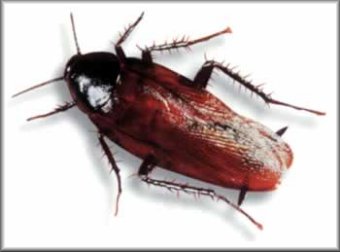 |
 |
 |
 |
Oriental Cockroach
Origin:
Believed to have originated in Africa, but now found throughout the world.
Biology:
Oriental roaches inhabit damp locations such as crawl spaces under structures or underground water and sewage systems. Their travel through such unsanitary habitats increases their potential as disease vectors. It may be common in outdoor environments and enter a structure on its own, by crawling under doors or through other exterior openings. Females carry their egg capsules for about one day, and then deposits the capsule in a secluded place. Each capsule has an average of 15 eggs, and the development from egg to mature adult takes about one year, although in some circumstances it has been observed to take about 2.5 years. The insects are nocturnal, avoid light, and neither sex can fly, although the male has well developed wings.
Identification:
These are large roaches, with adults reaching about 1 inch in length. They are very dark brown to black, with the females having an oval shape. The wings of the males do not reach the end of the abdomen, and the wings on the females are reduced to short stubs at the back of the thorax. The nymphs of this species are very similar to nymphs of the American roach, but may be distinguished by their cerci. On the Oriental roach the cerci are short and somewhat widened, while on the American they are long and thin.
Characteristics Important in Control: Since this species often enters structures by walking in or entering through drains of various kinds, entry points must be dealt with the exclude the insects. Removal of vegetation and harborage sites around the exterior of the building will reduce the presence near the structure. Granular insect baits appear to be very attractive to the Oriental roach, and applications of residual insecticides around building perimeters, in drain openings, or in sewer and storm system openings will help to control them.

WARNING
1. Apply chemicals only where needed or justified.
2. Before using any chemical, please read the label carefully for directions on application procedures, appropriate rate, first aid, storage, and disposal.
3. Make sure that the chemical is properly registered for use on the intended pest and follow all other label directions.
4. Keep insecticides in original containers, complete with labels, and keep them out of the reach of children and pets.
5. Do not allow children or pets near treated areas before these areas dry.
6. Carefully and properly dispose of unused portions of diluted sprays and empty insecticide containers.
|
|
|
|
 |
 |
|
|
 |
 |
 |
Read what our customers have to say about Bedbug King of New York
|
 |
 |
|
 |
|
 |
|

